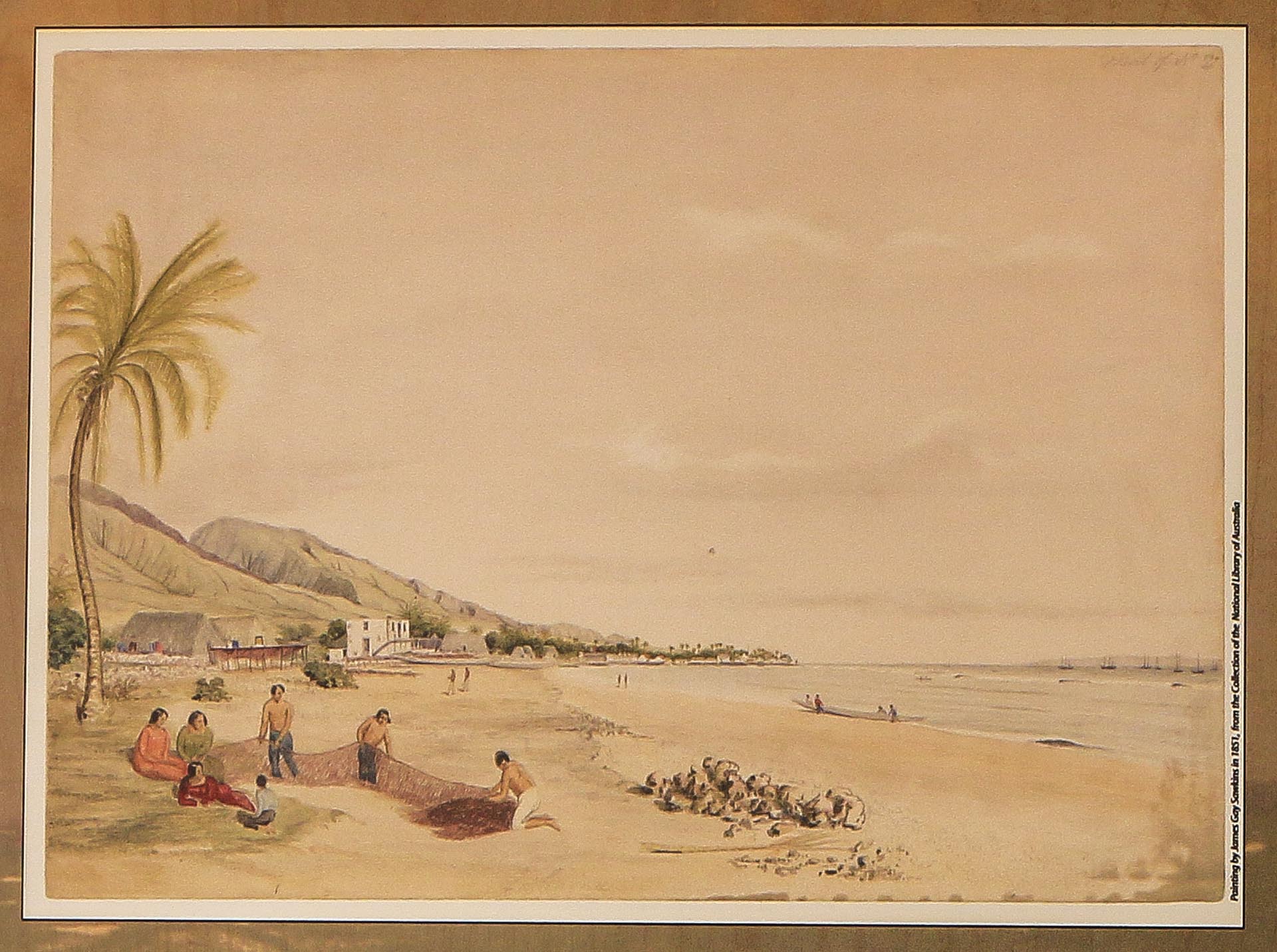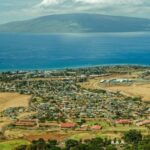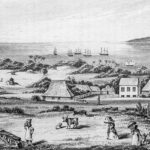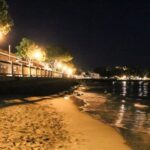
Kamehameha The Great
The Life And Times Of Kamehameha
Most people who visit Hawaii have heard of King Kamehameha. Many visitors see the name used everywhere. This is because of all the rulers of ancient Hawaii he was the most successful at conquering his rival island chiefs and then bringing together the people of all the islands under his rule.
From his conquests on the Big Island and the Hana side of Maui to his battles in Wailuku and Oahu, his life was often brutal and violent. In the end Kamehameha The Great was able to do what no other Hawaiian Ali’i (rulers or chiefs) could do, unite all the islands under one ruling institution – The Hawaiian Kingdom. He brought peace to the islands and ended what many believe was 100 years of war. The arrival of European ships brought continuous change to the ancient Hawaiian lifestyle after Kamehameha’s death in 1819.
This complicated caste society made up of family blood lines saw the ruling Ali’i as sacred Gods who ruled the people through a justly and sometimes brutal ancient Kapu system of governess.
What many people don’t realize is the struggle Kamehameha endured to achieve what other Ali’i at the time could not. His story is a fascinating glimpse into ancient Hawai’i and the transitions that followed the arrival of European and American influences.
The Future King Is Born
Starting from the day of his birth Kamehameha’s life was filled with danger and stories of survival. Kamehameha’s birth name was Paiea (meaning “Hard Shelled Crab). His mother Kekuiapoiwa was the daughter of Alapai, ruling chief of the Kona district and high chief Keoua who ruled the Kohala district on the Big Island of Hawai’i.
The date of his birth is debated among historians but Hawaiian legend tells of a bright star, Kokoiki, appearing just before his birth. The date of the legend may coincide with the appearance of Halley’s Comet in December of 1758.
When the star Kokoiki was viewed by the Kahuna (Hawaiian mystic priests) it was prophesied that a great leader was about to be born who would defeat all his rivals and come to rule all the islands. It was also said that the child was po’olua, meaning “child of two fathers”, due to a liaison his mother had with Kahekili who was the chief Ali’i and King of Maui. It was considered a great honor by the chiefs of that period.
The ruling chief Alapai became fearful of the prophesy and ordered the infant put to death. While Alapai’s chiefs waited outside the birthing hale (house) his mother’s attendants cut a hole in the structure and whisked away the infant within minutes of his birth. It is said he was taken into the mountains where the cold and rain caused the newborn royal infant to stop breathing. Attendants revived him and he stayed hidden for years from the warring clans who saw him as a potential threat. At this time he was given the name Kamehameha which means “The Very Lonely One” or “The One Set Apart”.
European Discovery
He eventually returned to his family and began training with his uncle Kalani’opu’u, then ruler of the Big Island of Hawai’i. As a young warrior he had tremendous size and strength. At close to 7 feet tall he proved himself as a great warrior and fulfilled another prophecy which stated that whoever could move the Naha Stone (said to have weighed over 2 tons) would unite the Hawaiian Islands. Kamehameha was able to roll it completely over.
By the time famed English explorer James Cook arrived Kamehameha was a trusted general in the Big Island’s ruler Kalani’opu’u armies. While colonists were battling the British during the American Revolutionary War the Hawaiian Islands were divided into four ruling kingdoms: the Big Island was under the rule of Kalani’opu’u who also had possession of the Hana district of Maui, the islands of Maui (except the Hana district), Lana’i, Moloka’i and Kaho’olawe were under the rule of Kahekili. The island of O’ahu was under the rule of Kahahana and the island of Kaua’i and Ni’ihau was under the rule of Kamakahelei. Kahekili also came very close to uniting the islands under his rule…but more about that later.
Captain Cook would purchase pigs for a piece of iron or barrel hoop which the Hawaiians used for axes or knives or fish-hooks. A large pig would get a knife for a chief. If a common man received anything, the chief had a right to take it. If it was concealed and discovered the man was killed.They called all iron pahoa – a tool for cutting, because there was once a sword among the old people of the Islands. Also Captain Cook was said to have been impressed with the extensive knowledge that Native Hawaiians had on cultivation. They traded sweet potatoes, bananas, coconuts and sugarcane. Cook remarked in his journal how friendly and good natured these natives seemed to be.
At Kahului a royal double hulled canoe came out to greet the ships. The Ali’i in the canoes boarded the Resolution with Kahekili, the Mo’i (supreme Chief or King) of Maui giving Captain Clerke a royal feathered cape. Days later as they sailed along Maui’s north shore another double hulled canoe came out to greet them. This time it was Big Island Mo’i Kalaniopu’u and Kamehameha who were both were invited aboard the HMS Discovery. Kamehameha spent the night on Cook’s ship studying the armaments and technology of the Europeans. After leaving Maui Captain Cook sailed in the channel between Maui and Hawaii for eleven days. On the second day of December he anchored near Kohala on the northern point of the Big island of Hawai’i. Days later the ships made their way to Kealakekua Bay and came ashore.
After landing at Kealakekua Bay a priest took Captain Cook into the nearby temple thinking he was their god Lono. There they gave him a place upon the platform with the images of the gods. The priest stepped back after putting the oloa (a small white tapa cloth worn while prayer was being recited) on Captain Cook along with the red cloak laaena, as was the custom with the gods. King Kalani’opu’u along with Kamehameha were present at Kealakekua Bay with Cook and his men as they drew heavily from the resources of the area to provision their ships. They left on February 4th, 1779 with increasing tensions between the natives and the crew.
As the days passed the native Hawaiians increasingly saw Captain Cook and crew as mere men instead of the gods they originally believed them to be. After leaving Kealakekua Captain Cook’s Death EtchingBay and sailing along the Kohala coast the ships encountered a gale. The Resolution’s mast was damaged and the ships were forced to return to Kealakekua Bay to make repairs. After iron tools were stolen along with one of the transport cutters Cook went ashore with nine marines with the intent to capture and hold Kalaniopu’u hostage for the return of the items. A confrontation ensued and Cook along with four marines were killed. Kamehameha was injured in the scuffle and Cook, Britain’s greatest navigator was dead at the age of 51. After the skirmish a truce was declared and the damaged mast was repaired. The Resolution and the Discovery left Hawai’i February 22 1779 under the command of Captain Charles Clerke and Captain James King.
Rise Of A Warrior
Kamehameha was a keen battle strategist and admirer of western weaponry. When the ruler of the Big Island King Kalani’opu’u died in 1782 Kamehameha received a powerful inheritance that was unusual at the time. His uncle left him the islands war god Kuka’ilimoku while giving his own son Kiwala’o control over the island. This caused much resentment for Kiwala’o and war was soon waged. Kamehameha had a temple built and invited Kiwala’o to meet with him. Upon his arrival at the newly constructed Heiau (Hawaiian temple) Kamehameha’s chiefs speared Kiwala’o to death, thus solidifying Kamehameha’s rule of the Big Island.
Though he battled with other Big Island districts in a short time, he was able to gain control of all the districts and began to set his sights on invading the rest of the island chain. His first conquest was the island of Maui.
Conquest Of The Islands
Battles For Maui
At the same time Kamehameha was securing the rule of the Big Island Kahekili, King of Maui, was plotting his own conquests. He first sent his warriors to overtake Hana. Kahekili sent his forces through Haleakala Crater where they split into two divisions. One came down the Ko’olau Gap above Ke’anae Peninsula and the other came down Kaupo Gap past Hana and invaded the village in a pincer move. The Big Island Ali’i who were in control of Hana fled as the warriors became stranded atop Ka’uiki Hill at the edge of Hana Bay.
The ensuing siege lasted for many months as the fortress on top of the hill proved to be well defended. After Kahekili discovered a freshwater spring that was sustaining the fortress he had it destroyed and was eventually successful in killing all the inhabitants and reestablishing his rule of Hana. Kahekili now controlled four islands and began working on conquering O’ahu.
While Kahekili was on O’ahu building political alliances to overtake the island, Kamehameha invaded Maui at Wailuku in 1790 near the royal compound of Kahekili. Today the Bailey House Museum in Wailuku resides within this ancient royal compound.
Western Allies & Influences
With the help of two foreigners, Isaac Davis and John Young, Kamehameha was able to implement weapons that his rivals did not have. Among these weapons was a swivel cannon taken from the ship Fair American. The ship was the unlucky recipient of the anger of a Big Island chief who had been insulted by a previous American ship captain. In the ensuing attack on the ship the entire crew was killed and the only survivor was Isaac Davis. It is said he fought bravely and though wounded was rescued and became a close confidant of Kamehameha.
With the canon given the name Lopaka it was mounted onto a war canoe with Davis and another stranded sailor from a different (John Young) the two became gunners for Kamehameha war fleet of hundreds of war canoes and upwards of 6000 men. Muskets from the ship were also used as the two foreigners taught the warriors, including the wives of high ranking Ali’i, how to use, maintenance and repair of firearms with lethal efficiency.
With the use of these weapons Kamehameha soundly defeated Kahekili’s army led by his son Kalanikapule in Iao Valley. The Maui warriors, under cannon fire, attempted to scale the steep cliff walls of the valley. The Iao River became so choked with bodies that it blocked the stream whose waters ran red with blood all the way down to Wailuku. The battle became known as Kepaniwai meaning “The Damming of the Waters”
Kahekili’s son Kalanikapule escaped through the mountains to Lahaina and sailed to O’ahu joining his father. Kahekili’s many years of war and conquest depleted the island of Maui but he was able to secure the rule of seven islands – all of them but the Big Island – through battles, marriages and family alliances. In the end he died on O’ahu in July of 1793. Kamehameha now set his sights on conquering O’ahu but first he needed to resupply and rebuild his forces. Shortly thereafter he learned of a revolt by the Big Island Ali’i which threatened his rule. He returned to the Big Island with his warriors and put down the revolt.
The Kingdom Of Hawai’i
Lahaina – The First Capital Of Hawai’i
After Defeating Kahekili’s forces and the revolt on his home island Kamehameha gathered his forces along the shores of Lahaina in preparation of invading O’ahu.
To keep the warriors enthusiastic he ordered the building of more war canoes. Dubbed the Lele Fleet it is said the canoes numbered over 800 and stretched for a mile from what is now Front Street. Several years past in preparation for the invasion of O’ahu. The decades of war waged by Kahekili had depleted the village of Lele (Lahaina) of its gardens and fish ponds and it is said Kamehameha ordered its restoration which included a network of canals throughout the village, which had earned the town the nickname “Venice of the Pacific” by newly arriving foreigners.
Kamehameha soon used his relationships with traders plying the Pacific during the American fur trade with Asia to build up an armory of western weapons while in Lahaina. The maritime fur trade was using Hawaii as a restocking port between China and Northwest America. Kamehameha shrewdly brokered for weapons and even ships. Foreign captains also traded for Sandalwood trees which were favored in China for its fragrance.
This resulted in the Hawaiian Sandalwood trade in which Kamehameha ordered the trees cut, hauled down the mountains on the backs of commoners and loaded into ship holds. Maui’s three layer canopy of sandalwood rainforest spread out along the slopes of Haleakala and the West Maui Mountains were clear cut by 1841 and have yet to recover, though reforestation efforts are underway today.
In 1802, King Kamehameha made Lahaina the capital of the Hawaiian Kingdom. He built a brick palace there along with residences, and other royal buildings and Lahaina served as the center of the Hawaiian government for over 50 years until permanently relocating to Honolulu for its harbor.
Battle For O’ahu
Knowing his enemy’s disadvantage, Kamehameha used his strong army and his fleet of canoes and small ships to conquer Maui, Lanaʻi, and Molokaʻi from Kahekili and his son Kalanikūpule’s rule in 1794. Kamehameha’s next target was Kalanikūpule’s base at Oʻahu. As Kamehameha prepared for war his former enemy Kahekili’s son Kalanikūpule was doing the same on O’ahu. Kalanikūpule had left Maui after his defeat by Kamehameha in Iao Valley to join his father in Waikiki. Kahekili died shortly after leaving control of four islands, O’ahu, Maui, Molokai, Lana’i and Kauai (through family ties and marriage) to his son Kalanikūpule.
A revolt on the Big Island saw Kamehameha returning to battle on the Big Island and Kalanikūpule and his uncle Kaeokulani were able to regain control of Molokai, Lana’i and Maui. Kalanikūpule put his uncle in charge of Maui but they soon had a falling out over who controlled the islands. His uncle Kaeokulani returned to O’ahu to confront Kalanikūpule and soon war broke out between them. At the same time three ships arrived in Waikiki, the first western ships to enter the harbor. One of the three ships was captained by William Brown who agreed to help Kalanikūpule with his war efforts against his uncle Kaeokulani. The battle on O’ahu saw his uncle’s forces driven into hiding in a steep ravine above Honolulu. Captain Brown spotted the Ali’i in the dense jungle from his ship just off shore by his ahuʻula, his scarlet and yellow feather cloak,. Firing from the ship Brown was able to guide Kalanikūpule’s men to their hiding spot where they were all were massacred. Shortly thereafter Kalanikūpule decided to steal the ship and it’s armaments. He killed Captain Brown and captured his crew and ship. As Kalanikūpule boarded the ship with his entourage the crew was able to overtake them and recaptured their ship. They set Kalanikūpule and his queen afloat in a canoe and departed for China.
While all this was going on Kamehameha, having put down the revolt on the Big Island, returned to Maui and began planning his conquest of O’ahu from his royal post in Lahaina. According to historians at the time:
“Four ships joined Kamehameha’s expedition to O’ahu. They were well armed and filled with his various armies which, perhaps by the counting of this time, numbered eight thousand warriors. “There were sixty-five Ali‘i in the chiefly corps who were in command over the various armies. The Ali‘i wahine who accompanied Kamehameha on this expedition and the young male and female ali‘i numbered two hundred or more. It is said that the total count of those on this expedition came to 8,624”. Kamehameha invaded O’ahu in 1774
Kamehameha’s warriors and Kalanikūpule fought a great battle at the summit of Nuʻuanu Pali which is known as the Battle of Nuʻuanu. Kamehameha’s forces drove Kalanikūpule’s men to the edge of a cliff, driving them like cattle over the edge of this 400’ precipice. Following his defeat, Kalanikūpule hid in the mountains for several months before being captured and sacrificed to Kamehameha’s war god, Kū-ka-ili-moku. His death brought an end to the Kingdom of Maui.
The last holdout was Kauai’s leader Ka’umu’ali’i, but he eventually made a deal with him to avoid battle, and by 1810, Kamehameha became the first king to rule all the Hawaiian Islands.
Kamehameha The Great & The Kapu System
Throughout his reign, Kamehameha upheld the tenets of traditional religion in the face of new cultural influences. Although he cultivated friendships and alliances with Westerners who could help maintain his status – like John Young and Isaac Davis who shared their weapons expertise – he tightly controlled Western business and political contacts with Hawaiians. Kamehameha and his chiefs supplied visiting ships with provisions during the fur trade and cut cargo-holds of sandalwood to pay for Western goods.
The Ali’i or ruling class in ancient Hawai’i developed a governing system that involved harsh punishments although by all accounts it rarely needed to be enforced. The Maka’ainana (commoners) understood their place and respected the sacredness of the Ali’i (royal) bloodlines. The system of creating a Kapu (meaning of the word is “Obey Or Die”) law or rule stretched out to all the islands. Some society-wide Kapu dealt with women’s roles in the society and some pertained to the natural environment. Kapu on fishing and farming for instance assured fish could spawn and trees could fruit undisturbed.
The Hawaiian socio-political structure was based on what was called the kapu system. This belief system was comprised of restrictions or taboos. However, the kapu system was broken by Liholiho, King Kamehameha’s son, soon after his death.
The Hawaiian’s established a hierarchical society based on strict rules. The society’s structure consisted of:
- Mo’i — The mo’i is the main ruler of a specific area, also considered as the king of the lands. The mo’i led the people during wars against neighboring clans or kingdoms and when performing religious rituals. A chief minister and a high priest served as his advisors.
- Ali’i — The ali’i or chiefs are next in line to the mo’i. The complex ranking system of the ali’i was based on family ties. Their duties included preparing meals for the mo’i, protecting him while he slept, and entertaining him through dances and chants.
- Priests — Priests are also highly respected in Hawaiian politics because the people were deeply spirituality. Called “kahuna,” these priests were revered by all because of their mastery of religious rites. Kahuna’s can also be composed of skilled craftsmen who may also specialize in other fields such as canoe building and medicine. Because people highly revered priests, some of the kahuna were given respect and recognition equal to or exceeding that of the chiefs or ali’i.
- Maka’ainana — These refer to the commoners or masses who make up most of the ancient Hawaiian population. These commoners performed most of the labor needed to sustain the community such as fishing, farming, and construction. They gathered and made many of the goods used by the community. They were also required to pay taxes to the mo’i during the time of Makahiki (harvest season) of ——-. The commoners would also fight for their chiefs and kings. One of the unique aspects of the Hawaiian society is that the maka’ainana could actually go and live in another area if the leaders and chiefs were too difficult to deal with. Members of this social class can also rebel if the ruling parties have become too much for them to handle.
- Kauwa — The kauwa are outcasts of the society. People in this class are usually slaves or prisoners of war.
Another aspect of culture that the Hawaiians excelled in is their recreational activities and physical skills. One of the main reasons Hawaiians excelled in arts, crafts, and skills is because they often had competitions to showcase their talents and entertain one another. From canoe races and swimming displays to war games and other athletic endeavors, the ancient Hawaiians had grand tournaments and competitions spanning neighboring regions and neighboring islands. Spectators often gambled on the outcomes of these competitions, especially the ali’i who often sponsored the strongest athletes.
One of Kamehameha’s personal kapu was Mamala Hoe (Law of the Splintered Paddle)
During a raid on Puna, Kamehameha pursued several fishermen and his foot got stuck in a rock crevice. Realizing the chief’s disadvantage, one of the fishermen struck him on the head with a paddle which splintered. As the first fisherman prepared to strike Kamehameha again, the other fisherman made a plea to his companion to spare Kamehameha. Deeply moved by this incident, Kamehameha later proclaimed a law to protect the defenseless and to ensure the safety of travelers. A version of the law was incorporated into the state constitution in1978.
These personal kapu solidified the sacred power of Hawaii’s ruling class, but women still had many restrictions on their lives…
Ali’i Wahine (Royal Women)
Women of Ancient Hawaii
The kapu system had many restrictions when it came to wahine (women). Though they were not harsh it was still a form of oppression that the Ali’i wahine tolerated only as long as they needed to. Women were considered unclean (probably due to menstruation) and had there own eating house and ovens separate from the men. Also women were not allowed to eat certain foods. This ‘ai kapu had several meanings. ‘Ai means to eat and in this case “kapu” means sacred. The word translates to “sacred eating”. Thusly women were not allowed to eat pork (the body form of the god Lono), bananas (body form of the god Kanaloa) and coconuts (body form of the god Ku). Taro (body form of the god Kane) was also kapu for women to cook and prepare. Isabella Abbott, a leading ethnobotanist of Hawaii theorizes that because of this kapu women relied heavily upon seaweeds as a food source, more so than other Pacific Islanders.
The ‘ai kapu was abolished after the death of Kamehameha in 1819 when his son became the Hawaiian Kingdom’s second monarch Liholiho, (Kamehameha ll). Acting with his mother Keopuolani and Queen Ka’ahumanu’s encouragement, he ate these forbidden foods with the women of his court. The gesture began a shift within the Hawaiian religion and new freedoms for women. It was a shrewd move among these two Ali’i Wahine (royal women) as it assured political power to the line of Kamehameha monarchs because it limited the power of the ali’i below them. Ka’ahumanu would guide the next two monarchs through the changes of western influences and a new religion.
In the book Kamehameha’s Children Today, by authors Charles Ahlo and Jerry Walker it was noted that “the women accompanied their husbands on these war expeditions, as well as the young male and female aliʻi. Most of these chiefesses who went with their husbands were adept at shooting a musket …”
Even though they were quite restricted by the kapu system, native Hawaiian women held much respect and power in ancient Hawai’i.
The Kamehameha Dynasty
The Kamehameha dynasty was the most enduring and best-documented line of Hawaiian rulers. As was the custom of ancient Hawai’i polygamy was often practiced by the Ali’i, especially the ruling Mo’i as a way to negotiate control of a region through marriage. Kamehameha had an estimated 30 wives and from them had 35 children (17 sons and 18 daughters) from 18 of the wives. Twelve of them did not bear any children. (according to authors Charles Ahlo and Jerry Walker)
Of Kamehameha’s wives, the most sacred was Keopuolani who was of a higher rank than Kamehameha, and her sons and grandsons continued the Kamehameha ruling lineage for many years after his death. Kamehameha’s favorite wife was Ka’ahumanu, the daughter of one of his war generals from Kona – Ke’eaumoku. Ka’ahumanu was born in Hana when it was controlled by Big Island chiefs, and she inherited the advisory role of her father upon his death. She became a powerful player in the King’s court during his lifetime and counseled his sons after his death. She was instrumental in abolishing the Kapu system and converted to Christianity. The Dynasty of Kamehameha ruled for close to 80 years because of her influence. Her statue can be seen at Ka’ahumanu Shopping Center in Kahului along Ka’ahumanu Avenue.
Kamehameha Day Celebrations & Events
King Kamehameha V began this holiday to honor his grandfather, King Kamehameha I, on June 11, 1872, and the day is just one of two honoring a Hawaiian monarch (the other is Prince Kuhio Day, held March 26). Kamehameha Day was one of the first holidays proclaimed when Hawaii became a state in 1959. Mayor of Honolulu John C Lane commented in 1916 – “Kamehameha Day was generally observed by the people. Elaborate preparations were made for the celebration of the day, with sumptuous feasts and sports, and every effort was brought to bear to ensure the success of the occasion.” “The celebration itself was characterized by a cheerful spirit and good-fellowship. ‘Aloha,’ the watchword that opened every heart and brightened every soul, was greeted on every side, and hospitality, unalloyed and unbounded, was displayed at every door. There was no distinction in race, color or creed.”
From its first observance the Kamehameha Day was celebrated by horse races, games and pageantry. King Kamehameha was said to have ridden one of the first horses in Hawai’i during his time in Lahaina and so loved the animals. Today the horse races have given way to parades, floats and Pa’u riders.
Kahului
Kamehameha Day is all about parades and processions. The town of Kahului on Maui’s northwestern shore is best known as the arriving point for all mainland flights to the island. It is also the commercial hub for all imports arriving in Kahului Harbor. The nearby town of Wailuku was the seat of power for the island in ancient times, and it still is today. The West Maui Mountains and Iao Valley are the backdrop to Kahului’s Kamehameha Day Parade.
Each year the Royal Order of Kamehameha I – Kahekili Chapter commemorates the life of Kamehameha in a procession down Kaahumanu Avenue in Kahului. The morning procession starts at the University of Hawaiʻi Maui College and concludes at Hoaloha Beach Park at the canoe Hale (house) near Maui Beach Hotel. Locals gather along the parade route, and the traditional royal Hawaiian procession of parade participants adds some ancient tradition to this colorful parade. It’s a great way to get some real Hawaiian culture from a local standpoint and a wonderful event to photograph.
Lahaina
The Lahaina parade for Kamehameha Day includes the celebratory Pa’u Parade. The beautifully dressed wahine (women) on horseback are adorned with flowers flowing from the riders and horses.
This celebration of Kamehameha The Great includes a Ho’olaule’a, which is a Hawaiian festival of music, food and games. This year there are multiple days as June 10th 2016 is also Lahaina’s First Friday Town Party with the Pa’u Parade on Saturday June 18th (9:45 am on Front Street) and a Ho’olaule’a on Sunday June 19th from 9am to 5pm at the Banyan Tree Park.
Check out the Facebook page for a listing of scheduled entertainment.
O’ahu
All the islands celebrate Kamehameha Day, usually with a parade, but the parade on O’ahu is the largest and most extravagant of them all. Thousands line the streets and this year is the 100th anniversary of this floral parade! It starts with the draping of Lei on the statue of Kamehameha on Friday, June 10th and the floral parade on June 11th at 9 am starting at Iolani Palace and proceeding to Queen Kapi’olani Park at the base of Diamond Head in Waikiki.
If you’re on O’ahu check out one of the largest celebrations of Hawaiian culture in the islands!
Well, there you have it. Hope you enjoyed learning about Hawaii’s first King and how this beautiful state was once its own kingdom. Though there is still some contention about how Hawaii was annexed by America, the culture has survived and is striving to uphold the honor and wisdom of ancestors like Kamehameha The Great.
Aloha Nui Loa
References
Using the links below you can purchase these books and other products on Amazon while supporting a cause of your choice. If you have not chosen an organization please help the Hawaii Ecotourism Association with your purchases.
Mary Kawena Pukui – Author and historian
Books:
Kamehameha’s Children Today, by authors Charles Ahlo and Jerry Walker
Ho`omana: Understanding the Sacred and Spiritual, by author Malcolm Naea Chun
Hawai’i Myth and Legends – by King David Kalakaua
Maui A History – by Cummings E Speakman Jr
Links












